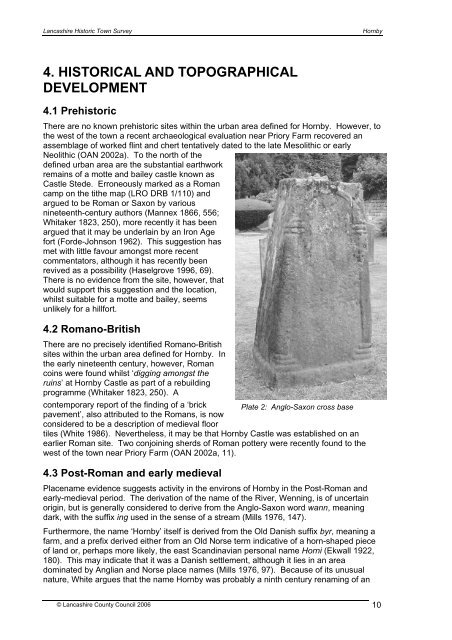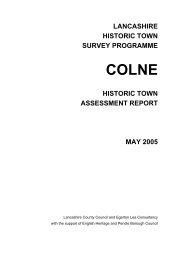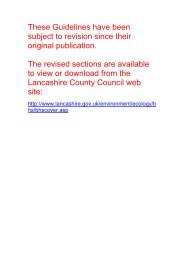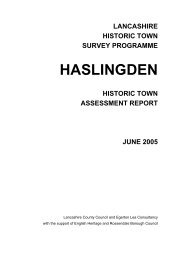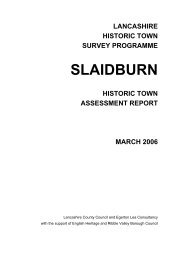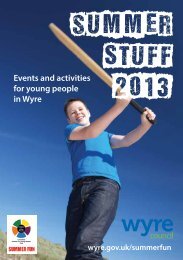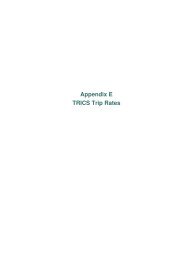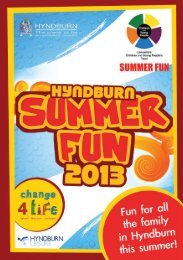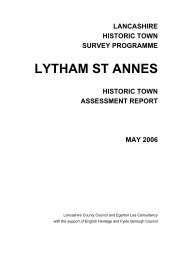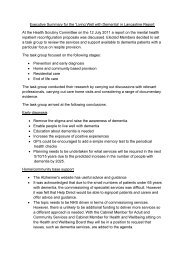HORNBY - Lancashire County Council
HORNBY - Lancashire County Council
HORNBY - Lancashire County Council
Create successful ePaper yourself
Turn your PDF publications into a flip-book with our unique Google optimized e-Paper software.
<strong>Lancashire</strong> Historic Town SurveyHornby4. HISTORICAL AND TOPOGRAPHICALDEVELOPMENT4.1 PrehistoricThere are no known prehistoric sites within the urban area defined for Hornby. However, tothe west of the town a recent archaeological evaluation near Priory Farm recovered anassemblage of worked flint and chert tentatively dated to the late Mesolithic or earlyNeolithic (OAN 2002a). To the north of thedefined urban area are the substantial earthworkremains of a motte and bailey castle known asCastle Stede. Erroneously marked as a Romancamp on the tithe map (LRO DRB 1/110) andargued to be Roman or Saxon by variousnineteenth-century authors (Mannex 1866, 556;Whitaker 1823, 250), more recently it has beenargued that it may be underlain by an Iron Agefort (Forde-Johnson 1962). This suggestion hasmet with little favour amongst more recentcommentators, although it has recently beenrevived as a possibility (Haselgrove 1996, 69).There is no evidence from the site, however, thatwould support this suggestion and the location,whilst suitable for a motte and bailey, seemsunlikely for a hillfort.4.2 Romano-BritishThere are no precisely identified Romano-Britishsites within the urban area defined for Hornby. Inthe early nineteenth century, however, Romancoins were found whilst ‘digging amongst theruins’ at Hornby Castle as part of a rebuildingprogramme (Whitaker 1823, 250). Acontemporary report of the finding of a ‘brick Plate 2: Anglo-Saxon cross basepavement’, also attributed to the Romans, is nowconsidered to be a description of medieval floortiles (White 1986). Nevertheless, it may be that Hornby Castle was established on anearlier Roman site. Two conjoining sherds of Roman pottery were recently found to thewest of the town near Priory Farm (OAN 2002a, 11).4.3 Post-Roman and early medievalPlacename evidence suggests activity in the environs of Hornby in the Post-Roman andearly-medieval period. The derivation of the name of the River, Wenning, is of uncertainorigin, but is generally considered to derive from the Anglo-Saxon word wann, meaningdark, with the suffix ing used in the sense of a stream (Mills 1976, 147).Furthermore, the name ‘Hornby’ itself is derived from the Old Danish suffix byr, meaning afarm, and a prefix derived either from an Old Norse term indicative of a horn-shaped pieceof land or, perhaps more likely, the east Scandinavian personal name Horni (Ekwall 1922,180). This may indicate that it was a Danish settlement, although it lies in an areadominated by Anglian and Norse place names (Mills 1976, 97). Because of its unusualnature, White argues that the name Hornby was probably a ninth century renaming of an© <strong>Lancashire</strong> <strong>County</strong> <strong>Council</strong> 2006 10


